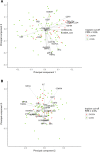Immune activation correlates with and predicts CXCR4 co-receptor tropism switch in HIV-1 infection
- PMID: 32985522
- PMCID: PMC7522993
- DOI: 10.1038/s41598-020-71699-z
Immune activation correlates with and predicts CXCR4 co-receptor tropism switch in HIV-1 infection
Abstract
HIV-1 cell entry is mediated by binding to the CD4-receptor and chemokine co-receptors CCR5 (R5) or CXCR4 (X4). R5-tropic viruses are predominantly detected during early infection. A switch to X4-tropism often occurs during the course of infection. X4-tropism switching is strongly associated with accelerated disease progression and jeopardizes CCR5-based HIV-1 cure strategies. It is unclear whether host immunological factors play a causative role in tropism switching. We investigated the relationship between immunological factors and X4-tropism in a cross-sectional study in HIV-1 subtype C (HIV-1C)-infected patients and in a longitudinal HIV-1 subtype B (HIV-1B) seroconverter cohort. Principal component analysis identified a cluster of immunological markers (%HLA-DR+ CD4+ T-cells, %CD38+HLA-DR+ CD4+ T-cells, %CD38+HLA-DR+ CD8+ T-cells, %CD70+ CD4+ T-cells, %CD169+ monocytes, and absolute CD4+ T-cell count) in HIV-1C patients that was independently associated with X4-tropism (aOR 1.044, 95% CI 1.003-1.087, p = 0.0392). Analysis of individual cluster contributors revealed strong correlations of two markers of T-cell activation (%HLA-DR+ CD4+ T-cells, %HLA-DR+CD38+ CD4+ T-cells) with X4-tropism, both in HIV-1C patients (p = 0.01;p = 0.03) and HIV-1B patients (p = 0.0003;p = 0.0001). Follow-up data from HIV-1B patients subsequently revealed that T-cell activation precedes and independently predicts X4-tropism switching (aHR 1.186, 95% CI 1.065-1.321, p = 0.002), providing novel insights into HIV-1 pathogenesis and CCR5-based curative strategies.
Conflict of interest statement
The authors declare no competing interests.
Figures
References
Publication types
MeSH terms
Substances
Grants and funding
LinkOut - more resources
Full Text Sources
Medical
Research Materials


